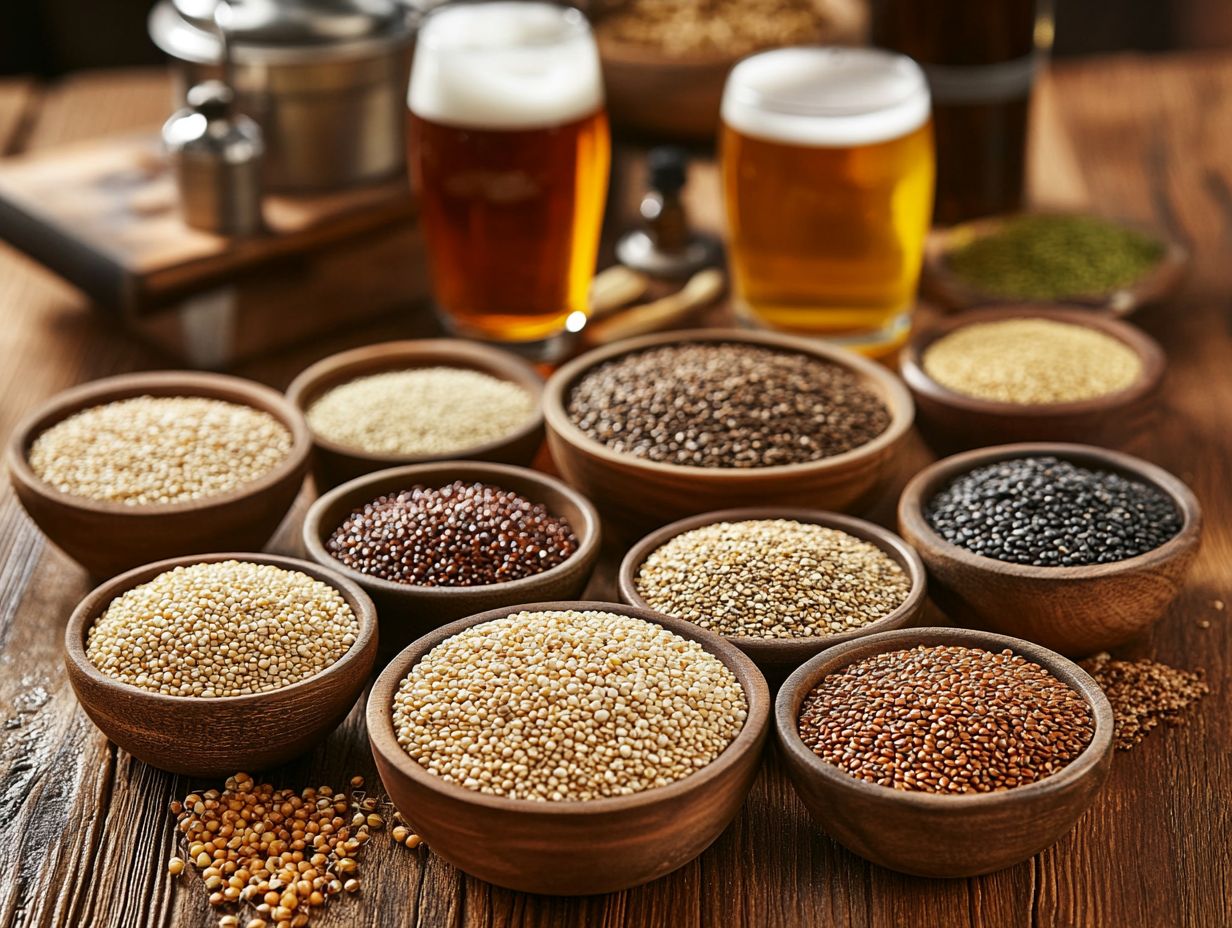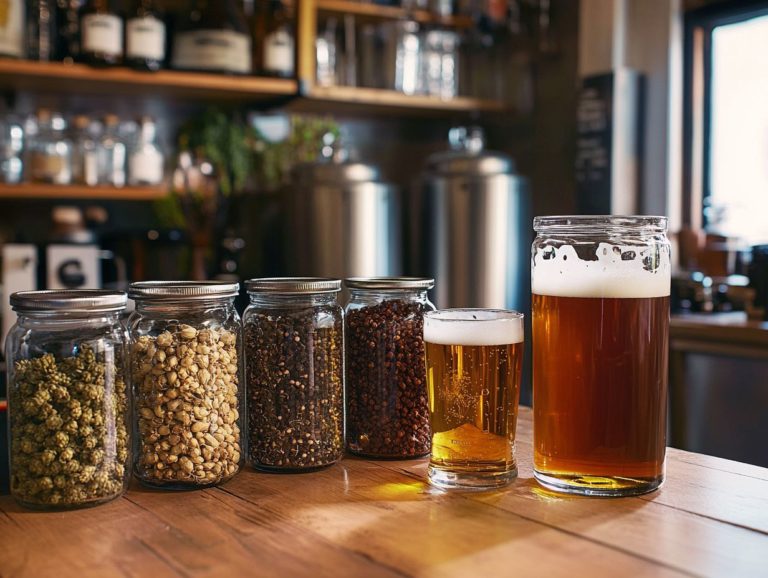Exploring Alternative Grains for Brewing
Alternative grains are increasingly making their mark in the brewing industry, as craft brewers strive to craft unique flavors while accommodating a variety of dietary preferences. By including grains like barley, wheat, rye, rice, corn, and oats, brewers enhance their beer production with unique flavors and textures.
Delve into the intriguing world of alternative grains, where gluten-free selections and ancient varieties await your discovery. Witness how these grains are skillfully integrated into the brewing process, including innovative brewing techniques and local farming practices.
Uncover the advantages they bring to the table, including their effects on flavor, color, and alcohol content. Additionally, you’ll find practical tips to seamlessly incorporate these grains into your brewing adventures, such as understanding the malting process and enzyme activity.
Contents
- Key Takeaways:
- What are Alternative Grains?
- How Are Alternative Grains Used in Brewing?
- Types of Alternative Grains
- 2. Ancient Grains
- 3. Pseudo-Cereals
- How Do Alternative Grains Affect the Brewing Process?
- Tips for Using Alternative Grains in Brewing
- Frequently Asked Questions
- What are alternative grains for brewing?
- Why should I explore alternative grains for brewing?
- What are the benefits of using alternative grains for brewing?
- How do I incorporate alternative grains into my brewing process?
- Are there any challenges to using alternative grains for brewing?
- What are some examples of beers made with alternative grains?
Key Takeaways:

- Alternative grains offer a variety of unique flavors in brewing, such as nutty, earthy, and spicy notes.
- Using alternative grains can provide health benefits, as some are gluten-free and rich in nutrients, increasing the protein content and essential nutrients in your brew.
- Experimenting with alternative grains can enhance the complexity and depth of flavor in beer, creating a unique and enjoyable drinking experience.
What are Alternative Grains?
Alternative grains represent a fascinating array of cereal crops that can be leveraged for a multitude of applications beyond their conventional uses. This category includes grains like barley, wheat, rye, rice, corn, and oats, all of which are gaining traction in the brewing industry due to their distinctive qualities.
You ll find that many craft breweries are embracing the incorporation of these alternative grains, especially those committed to sustainable brewing practices and sourcing local ingredients. By adapting these grains into their brewing methods, brewers can enhance efficiency while crafting innovative beer styles that meet the rising demand for gluten-free options and unique flavor profiles.
1. Examples of Alternative Grains
Consider the world of alternative grains, where traditional and ancient varieties like barley, wheat, rye, rice, corn, and oats are making a remarkable entrance into the craft brewing scene. These grains not only enrich the flavor profiles of your brews but also bring unique brewing properties that can elevate the final product.
Take oats, for example; they are celebrated for imparting a creamy mouthfeel to your beer. On the other hand, rye introduces a delightful spiciness that adds complexity to your creations. Craft breweries such as Dogfish Head and Sierra Nevada have boldly experimented with these grains, crafting innovative beers that challenge the conventions of traditional styles such as IPAs, stouts, and hefeweizens.
Utilizing rice can provide a lighter, crisper taste, making it a fantastic choice for those refreshing summery ales and American light lagers. Embrace these grains to explore distinct brewing techniques and ultimately create beers that are both captivating and steeped in a rich heritage.
2. Benefits of Using Alternative Grains
The advantages of incorporating alternative grains in brewing are numerous, ranging from enhanced brewing efficiency to the development of distinctive flavors, particularly in gluten-free beer options.
By integrating grains like millet, quinoa, and buckwheat, you can elevate the sensory profiles of your beverages while meeting the growing demand for gluten-free products. These alternative grains not only bring exciting complexity to the taste but also provide health benefits, such as increased protein content and essential nutrients.
Embracing these grains showcases a commitment to sustainable practices, as many breweries prioritize local sourcing to reduce their environmental footprint. This strategy supports local farmers and ensures that you re using fresher ingredients, ultimately enriching the craft brewing experience and appealing to discerning consumers who value quality and sustainability in their choices.
Start experimenting with alternative grains today and transform your brewing game! Don t miss out on the chance to revolutionize your brewing with these incredible grains!
How Are Alternative Grains Used in Brewing?
Incorporating alternative grains into the brewing process fundamentally transforms traditional methods. You adapt mashing and fermentation techniques to enhance both the flavor and texture of the final product, elevating the overall brewing experience.
1. Mashing and Fermentation Process

In the mashing process, you’ll find that alternative grains interact in intriguing ways, all thanks to their unique enzyme activity. This interaction is crucial. It shapes the fermentation process and affects the flavors in your handmade beer. The gelatinisation and malt quality of these grains can significantly impact the final profile of the beer.
As you mash these grains be it oats, rye, or buckwheat you combine them with water and apply heat, which activates enzymes like amylase. These enzymes are essential as they break down starches into fermentable sugars, the lifeblood of yeast metabolism.
Each grain type brings its own distinct sugars and proteins to the mix, influencing the fermentation dynamics in fascinating ways. For example, rye can infuse a spicier profile, while oats might offer a luxurious creamy mouthfeel.
The yeast s behavior will also vary depending on the sugar composition, resulting in a delightful array of esters and phenolic compounds that ultimately define the aroma and taste of your finished brew.
Your choice of grains is not merely a matter of preference; it s a strategic decision that enhances sugar conversion and enriches the overall flavor complexity of your brewing process.
2. Flavor Profiles of Alternative Grains
Alternative grains bring distinctive flavors to your handmade beer, often enhancing umami notes and creating unique flavor profiles that set different beer styles apart. These unique brewing grains offer opportunities to create hazy beers and other malt-forward beers.
Sorghum, millet, and buckwheat are just a few of the grains that introduce a range of taste characteristics, elevating a brew’s complexity and appeal. For example, sorghum adds a subtle sweetness, making it a superb choice for gluten-free beers. Meanwhile, millet offers a delightful nutty aroma that pairs beautifully with traditional styles like blonde ales. Buckwheat, with its earthy and dry finish, truly excels in darker beers, such as stouts, where its robust flavor complements roasted malt notes.
As you explore the world of craft beer, seeking diverse and intriguing taste experiences, you’ll find that incorporating alternative grains not only broadens the flavor spectrum but also invites you to appreciate the artistry involved in brewing.
Types of Alternative Grains
You can categorize the various types of alternative grains into three distinct groups: gluten-free grains, ancient grains, and pseudo-cereals. Each of these categories brings its own unique properties to the table, enhancing both brewing and cooking in remarkable ways.
1. Gluten-Free Grains
Gluten-free grains such as rice, corn, and oats have become essential in the brewing industry, catering to your growing desire for gluten-free craft beer options. These grains offer a delicious alternative for those with celiac disease or gluten intolerance, allowing you to savor flavorful brews without compromising your health.
Craft breweries are increasingly welcoming these grains into their recipes. Take oat-based beers, for instance; they provide a creamy texture and enhanced mouthfeel that you ll appreciate. Meanwhile, rice delivers a crisp and clean taste that elevates your drinking experience.
Breweries like DogFish Head are even experimenting with corn to craft refreshing summer ales that appeal to a broader audience. This innovative approach not only addresses market demands but also enriches the beer landscape, ensuring that gluten-free options maintain a high standard of quality and flavor richness that you can truly enjoy. The incorporation of adjunct brewing techniques fosters creative and unique brewing techniques.
2. Ancient Grains
Ancient grains like barley, quinoa, and millet are making a stylish comeback in the craft brewing scene. They are celebrated for their impressive nutritional benefits and rich historical significance.
This resurgence isn t just a nostalgic nod; it reflects the growing awareness among brewers and consumers about health-conscious choices and sustainability. These grains offer a treasure trove of flavors. You can find everything from the nutty undertones of spelt to the subtly sweet notes of buckwheat.
Noteworthy craft breweries, such as Dogfish Head and New Belgium, incorporate these ancient grains into their recipes. They create unique brews that tantalize your palate and celebrate the diversity of ingredients. This trend is transforming craft beer into an exciting flavor adventure that beautifully intertwines tradition with innovation.
This movement, supported by the Artisan Grain Collaborative, emphasizes the importance of heritage grains and sustainable brewing.
3. Pseudo-Cereals

Pseudo-cereals, such as quinoa, buckwheat, and amaranth, are increasingly capturing attention in the brewing industry. Their distinctive nutritional profiles and remarkable versatility in brewing techniques make them popular choices.
These grains also provide exceptional flavor and texture. They elevate your beer-drinking experience to new heights. Brewmasters embrace these alternative grains, expertly blending them with traditional barley and wheat to create innovative and captivating brews.
Incorporating pseudo-cereals enhances the complexity of the beer. It introduces valuable nutritional benefits that appeal to health-conscious consumers. Their gluten-free nature makes them a fantastic option for brews designed for those with dietary restrictions.
As the craft beer movement continues to thrive, the fusion of pseudo-cereals with conventional grains opens up a world of exciting opportunities for creative exploration in brewing.
How Do Alternative Grains Affect the Brewing Process?
Alternative grains play an important role in the brewing process, influencing elements from flavor and mouthfeel to brewing efficiency and the overall fermentation journey (the process where yeast converts sugars into alcohol). Embracing these grains allows you to explore new dimensions in your brews.
This exploration enhances the taste, complexity, and character of your creations.
1. Impact on Flavor
Incorporating alternative grains can significantly transform the flavor profile of craft beer. This results in unique tastes that shine especially bright in malt-forward varieties.
This distinction becomes particularly fascinating when comparing traditional grains like barley with alternatives such as quinoa, rye, or even buckwheat. Each grain contributes its own character to the brewing process.
For instance, rye infuses spicy notes that enhance the complexity of a robust porter. At the same time, buckwheat lends a light, earthy flavor that harmonizes beautifully with lighter ales.
Craft beer styles like American Wheat or Saison often utilize these grains to elevate the tasting experience. This allows brewers to experiment and craft nuanced profiles that stand apart from those made with conventional grains.
As you seek out these innovative options, you ll find the craft beer landscape expanding. It invites you on a delightful adventure of flavor exploration.
2. Impact on Color
Alternative grains play a pivotal role in shaping the color of craft beer. Different grains provide a spectrum of hues from light and vibrant to dark and rich. When selecting ingredients as a brewer, the choice of grains can dramatically influence the visual appeal of the final product.
For instance, pale malts tend to yield bright, golden shades, often seen in refreshing light lagers or wheat beers. On the flip side, roasted malts are the go-to for stouts and porters. They result in deep, dark brown or even black beers that command attention. This interplay between grain selection and beer color does more than enhance aesthetics; it also influences how the beer tastes, as darker brews are frequently linked to more robust flavors.
By understanding these details, you can truly appreciate the artistry behind your favorite beers and the craftsmanship that goes into creating each unique brew.
3. Impact on Alcohol Content
The choice of alternative grains can significantly influence the final alcohol content of your craft beer, depending on their performance during fermentation and the brewing techniques you employ.
Different grains, such as millet, rice, and oats, introduce a variety of unique sugars that differ in their fermentability. Some grains yield a higher sugar content, resulting in increased alcohol levels once fermented, while others provide complex flavor profiles without notably raising the alcohol content.
Your skillful selection of these grains directly impacts not only the drink s potency but also its flavor, body, and mouthfeel. It’s essential to carefully balance these elements to craft a beer that aligns with your intended style and alcohol target. This makes grain selection a crucial aspect of the brewing process.
Tips for Using Alternative Grains in Brewing

When you set out to implement alternative grains in brewing, you’ll find that it demands particular techniques and considerations. This approach is essential for optimizing malt quality and brewing efficiency, as well as achieving those nuanced flavor profiles you desire.
Frequently Asked Questions
What are alternative grains for brewing?
Alternative grains for brewing are grains that are not traditionally used in beer making, such as sorghum, quinoa, millet, and buckwheat. These grains offer unique flavors and textures and can be used as substitutes for traditional malted barley.
Why should I explore alternative grains for brewing?
Exploring alternative grains for brewing can add diversity and creativity to your beer making. These grains provide a different flavor profile and can give your beer a unique twist. It also allows for experimentation and the chance to create a truly original brew.
What are the benefits of using alternative grains for brewing?
Alternative grains offer a range of benefits, such as being gluten-free, adding different flavor profiles, and being more sustainable and environmentally friendly. They can also provide additional nutrients and vitamins to your beer.
How do I incorporate alternative grains into my brewing process?
To incorporate alternative grains, you can either use them as a substitute for traditional malted barley or mix them with barley to create a blended grain bill. You may also need to adjust your brewing process, such as milling the grains differently or using a different mash temperature.
Are there any challenges to using alternative grains for brewing?
Yes, there can be some challenges when using alternative grains for brewing. These grains may require different equipment or techniques, and they may also have lower enzymatic activity, which can impact the conversion of starches into sugars.
What are some examples of beers made with alternative grains?
There are many examples of beers made with alternative grains, such as gluten-free beers made with sorghum and millet, Belgian witbiers made with wheat, and Scottish ales made with oats. You can also find more unique and experimental beers using quinoa, buckwheat, and other alternative grains.






